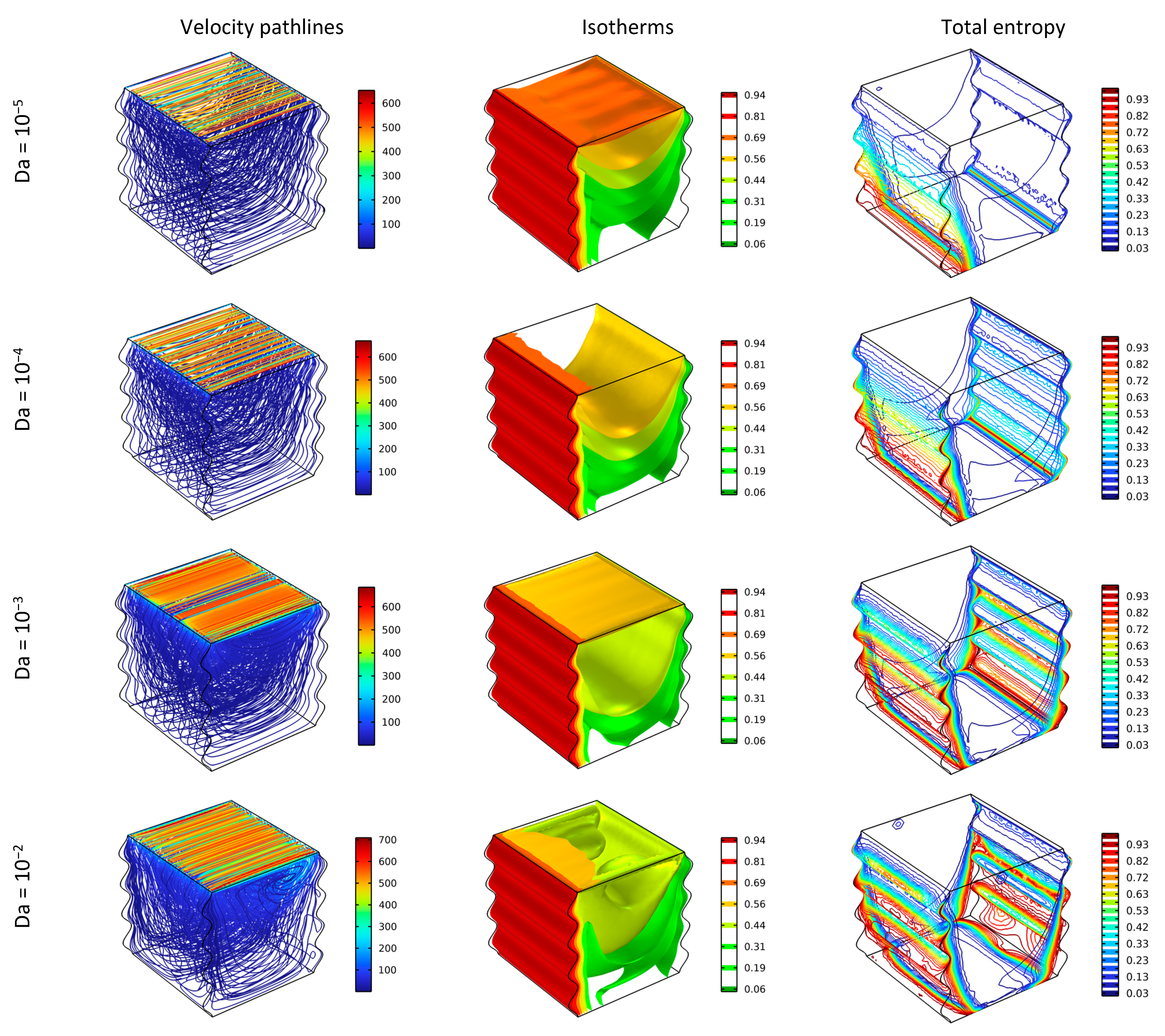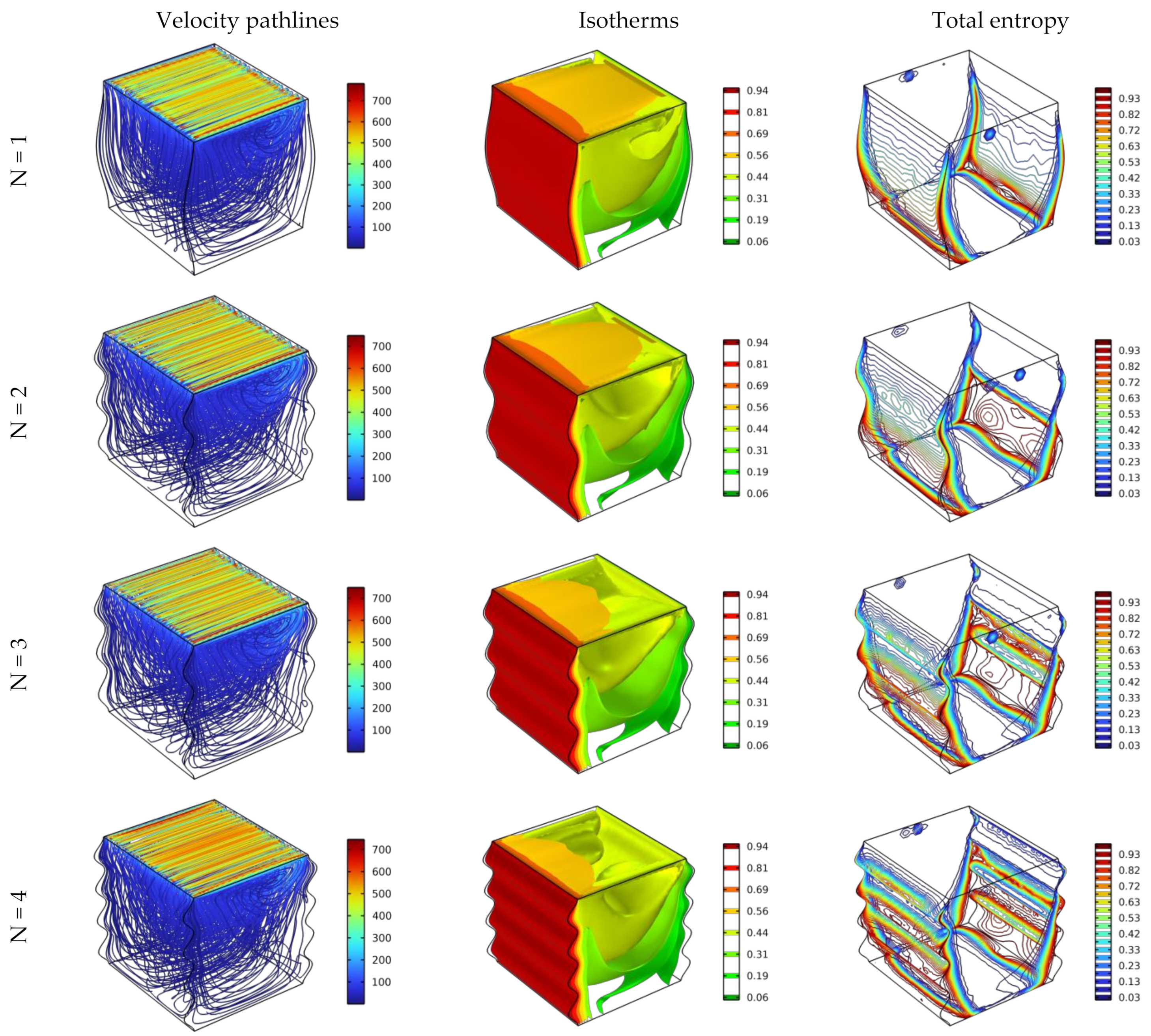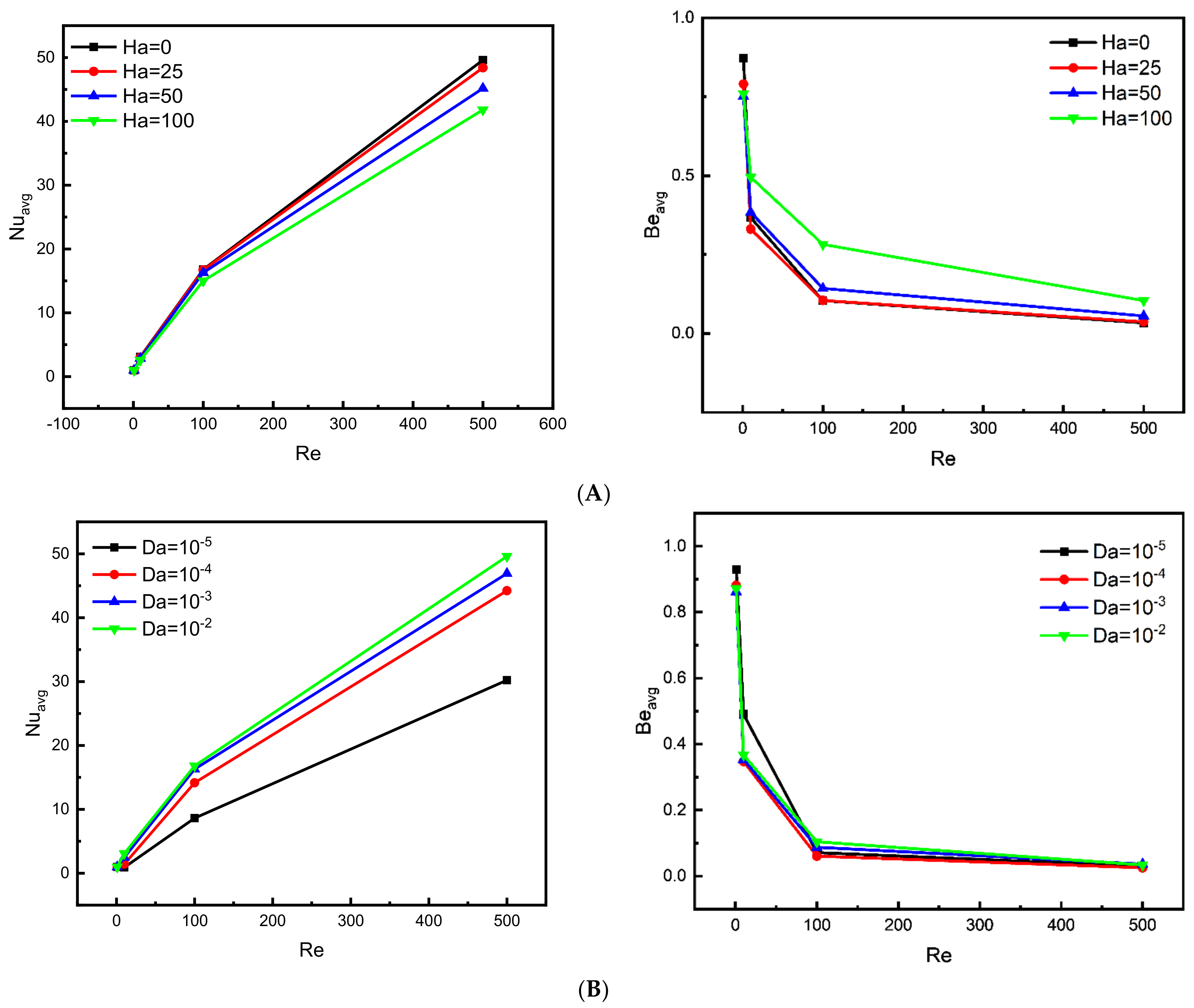Numerical Study of Lid-Driven Hybrid Nanofluid Flow in a Corrugated Porous Cavity in the Presence of Magnetic Field
Abstract
:1. Introduction
2. Mathematical Model
3. Numerical Method and Validation
4. Results and Discussion
5. Conclusions
- The flow motion is directly related to the Darcy and Reynolds numbers, as a result, both heat transfer and the Nusselt number enhance by extending these numbers.
- The magnetic field is always an undesirable factor in heat transfer, as it reduces the fluid motion, in return, the effectiveness of the convection mode is diminished.
- The undulation pattern has an active role in improving the heat distribution by increasing the fluid motion, especially near the wavy walls.
- Increasing the Darcy or Reynolds numbers builds up the entropy that is generated from fluid frictions and reduces the Bejan number in other parts.
- Despite the increased entropy production due to heat transfer by enriching the peaks of the wavy walls, the Bejan number decreases because the entropy generation caused by fluid friction is higher than the entropy caused by the heat transfer.
- The magnetic field negatively affects the fluid friction entropy, causing the entropy production resulting from the conduction heat transfer mode to be dominated, thus, the Bejan number reaches high values as the Hartman number increases.
Author Contributions
Funding
Institutional Review Board Statement
Informed Consent Statement
Data Availability Statement
Acknowledgments
Conflicts of Interest
Nomenclatures
| Symbols | |
| B | Magnetic field |
| Be | Bejan number |
| cp | Specific heat (J·kg−1 K−1) |
| Da | Darcy number |
| g | Gravitational acceleration, (m·s−2) |
| Ha | Hartman number |
| k | Thermal conductivity, (W·m−1·K−1) |
| L | Cavity width, (m) |
| Nu | Nusselt number |
| P | Dimensionless pressure |
| Pr | Prandtl number |
| Ra | Rayleigh number |
| Re | Reynolds number |
| Ri | Richardson number |
| S | Entropy generation |
| T | Temperature, (K) |
| u, v, w | Velocities in x, y, z-directions, (m·s−1) |
| U, V, W | Dimensionless velocities component in X, Y, Z-directions |
| X, Y, Z | Dimensionless coordinates in x, y, z directions |
| Greek letters | |
| Thermal diffusivity (m2·s−1) | |
| Thermal expansion coefficient (K−1) | |
| Porosity | |
| Dimensionless temperature | |
| Permeability, (m2) | |
| Dynamic viscosity (Pa·s) | |
| Kinematic viscosity, (m2·s−1) | |
| Density, (kg/m3) | |
| Electrical conductivity, (Ω−1·m−1) | |
| φ | Nanoparticle concentration |
| Subscript | |
| f | fluid |
| Ff, FF | Fluid friction |
| hnf | Hybrid-nanofluid |
| Mf, MF | Magnetic field |
| nf | Nano-fluid |
| np | Nano-particle |
| s | Solid matrix |
| hT, HT | Thermal |
| Tot, TOT | Total |
References
- Tembhare, S.P.; Barai, D.P.; Bhanvase, B.A. Performance evaluation of nanofluids in solar thermal and solar pho-tovoltaic systems: A comprehensive review. Renew. Sustain. Energy Rev. 2022, 153, 111738. [Google Scholar] [CrossRef]
- Kumar, L.H.; Kazi, S.; Masjuki, H.; Zubir, M. A review of recent advances in green nanofluids and their application in thermal systems. Chem. Eng. J. 2021, 429, 132321. [Google Scholar] [CrossRef]
- Mukherjee, S.; Ebrahim, S.; Mishra, P.C.; Ali, N.; Chaudhuri, P. A Review on Pool and Flow Boiling Enhancement Using Nanofluids: Nuclear Reactor Application. Processes 2022, 10, 177. [Google Scholar] [CrossRef]
- Ben Said, L.; Kolsi, L.; Ghachem, K.; Almeshaal, M.; Maatki, C. Application of nanofluids as cutting fluids in machining operations: A brief review. Appl. Nanosci. 2022, 1–32. [Google Scholar] [CrossRef]
- Zahmatkesh, I.; Sheremet, M.; Yang, L.; Heris, S.Z.; Sharifpur, M.; Meyer, J.P.; Ghalambaz, M.; Wongwises, S.; Jing, D.; Mahian, O. Effect of nanoparticle shape on the performance of thermal systems utilizing nanofluids: A critical review. J. Mol. Liq. 2020, 321, 114430. [Google Scholar] [CrossRef]
- Tadesse, F.B.; Makinde, O.D.; Enyadene, L.G. Mixed Convection of a Radiating Magnetic Nanofluid past a Heated Permeable Stretching/Shrinking Sheet in a Porous Medium. Math. Probl. Eng. 2021, 2021, 6696748. [Google Scholar] [CrossRef]
- Jasim, L.M.; Hamzah, H.; Canpolat, C.; Sahin, B. Mixed convection flow of hybrid nanofluid through a vented enclosure with an inner rotating cylinder. Int. Commun. Heat Mass Transf. 2020, 121, 105086. [Google Scholar] [CrossRef]
- Jamaludin, A.; Nazar, R.; Naganthran, K.; Pop, I. Mixed convection hybrid nanofluid flow over an exponentially accelerating surface in a porous media. Neural Comput. Appl. 2021, 33, 15719–15729. [Google Scholar] [CrossRef]
- Celik, H.; Mobedi, M.; Manca, O.; Buonomo, B. Enhancement of Heat Transfer in Partially Heated Vertical Channel Under Mixed Convection by Using Al2O3 Nanoparticles. Heat Transf. Eng. 2017, 39, 229–240. [Google Scholar] [CrossRef]
- Hasan, M.S.; Chanda, R.K.; Mondal, R.N.; Lorenzini, G. Effects of rotation on unsteady fluid flow and forced convection in the rotating curved square duct with a small curvature. Facta Univ. Ser. Mech. Eng. 2022, 20. [Google Scholar] [CrossRef]
- Darzi, A.A.R.; Farhadi, M.; Lavasani, A.M. Two phase mixture model of nano-enhanced mixed convection heat transfer in finned enclosure. Chem. Eng. Res. Des. 2016, 111, 294–304. [Google Scholar] [CrossRef]
- Abu-Nada, E.; Chamkha, A.J. Mixed convection flow of a nanofluid in a lid-driven cavity with a wavy wall. Int. Commun. Heat Mass Transf. 2014, 57, 36–47. [Google Scholar] [CrossRef]
- Alsabery, A.; Sheremet, M.; Chamkha, A.; Hashim, I. Energy transport of two-phase nanofluid approach inside a three-dimensional lid-driven cubic cavity containing solid cylinder and heat source. Chem. Eng. Process. Process Intensif. 2020, 154, 108010. [Google Scholar] [CrossRef]
- Aljabair, S.; Ekaid, A.L.; Ibrahim, S.H.; Alesbe, I. Mixed convection in sinusoidal lid driven cavity with non-uniform temperature distribution on the wall utilizing nanofluid. Heliyon 2021, 7, e06907. [Google Scholar] [CrossRef]
- Louaraychi, A.; Lamsaadi, M.; Naïmi, M.; El Harfi, H.; Kaddiri, M.; Raji, A.; Hasnaoui, M. Mixed convection heat transfer correlations in shallow rectangular cavities with single and double-lid driven boundaries. Int. J. Heat Mass Transf. 2018, 132, 394–406. [Google Scholar] [CrossRef]
- Marzougui, S.; Mebarek-Oudina, F.; Magherbi, M.; Mchirgui, A. Entropy generation and heat transport of Cu–water nanoliquid in porous lid-driven cavity through magnetic field. Int. J. Numer. Methods Heat Fluid Flow 2021, 32, 2047–2069. [Google Scholar] [CrossRef]
- Rashidi, M.M.; Sadri, M.; Sheremet, M.A. Numerical Simulation of Hybrid Nanofluid Mixed Convection in a Lid-Driven Square Cavity with Magnetic Field Using High-Order Compact Scheme. Nanomaterials 2021, 11, 2250. [Google Scholar] [CrossRef]
- Nath, R.; Murugesan, K. Impact of nanoparticle shape on thermo-solutal buoyancy induced lid-driven-cavity with inclined magnetic-field. Propuls. Power Res. 2022, 11, 97–117. [Google Scholar] [CrossRef]
- Kumar, A.V.; Jino, L.; Doley, S.; Berlin, M. Magnetic Field Effect on Lid-Driven Porous Cavity Heated to the Right Wall. Sci. Technol. Asia 2021, 26, 27–38. [Google Scholar]
- Ali, I.R.; Alsabery, A.I.; Bakar, N.A.; Roslan, R. Mixed Convection in a Double Lid-Driven Cavity Filled with Hybrid Nanofluid by Using Finite Volume Method. Symmetry 2020, 12, 1977. [Google Scholar] [CrossRef]
- Oztop, H.F.; Zhao, Z.; Yu, B. Fluid flow due to combined convection in lid-driven enclosure having a circular body. Int. J. Heat Fluid Flow 2009, 30, 886–901. [Google Scholar] [CrossRef]
- Oztop, H.F.; Al-Salem, K.; Pop, I. MHD mixed convection in a lid-driven cavity with corner heater. Int. J. Heat Mass Transf. 2011, 54, 3494–3504. [Google Scholar] [CrossRef]
- Garmroodi, M.D.; Ahmadpour, A.; Talati, F. MHD mixed convection of nanofluids in the presence of multiple rotating cylinders in different configurations: A two-phase numerical study. Int. J. Mech. Sci. 2018, 150, 247–264. [Google Scholar] [CrossRef]
- Sheikholeslami, M.; Chamkha, A.J. Flow and convective heat transfer of a ferro-nanofluid in a double-sided lid-driven cavity with a wavy wall in the presence of a variable magnetic field. Numer. Heat Transfer. Part A Appl. 2016, 69, 1186–1200. [Google Scholar] [CrossRef]
- Abu-Hamdeh, N.H.; Oztop, H.F.; Alnefaie, K.A. A computational study on mixed convection in a porous media filled and partially heated lid-driven cavity with an open side. Alex. Eng. J. 2020, 59, 1735–1750. [Google Scholar] [CrossRef]
- Ahmed, S.E.; Hussein, A.K.; Mansour, M.A.; Afrand, M.; Morsy, Z.; Kolsi, L. Effect of magnetic field on the mixed convection in double lid-driven porous cavities filled with micropolar nanofluids. Numer. Methods Partial Differ. Equ. 2022, 38, 1090–1111. [Google Scholar] [CrossRef]
- Shah, S.S.; ul Haq, R.; McCash, L.B.; Bahaidarah, H.M.; Aziz, T. Numerical simulation of lid driven flow in a curved corrugated porous cavity filled with CuO-water in the presence of heat generation/absorption. Alex. Eng. J. 2022, 61, 2749–2767. [Google Scholar] [CrossRef]
- Ahmed, S.E.; Mansour, M.; Alwatban, A.M.; Aly, A. Finite element simulation for MHD ferro-convective flow in an inclined double-lid driven L-shaped enclosure with heated corners. Alex. Eng. J. 2020, 59, 217–226. [Google Scholar] [CrossRef]
- Al-Amiri, A.; Khanafer, K.; Bull, J.; Pop, I. Effect of sinusoidal wavy bottom surface on mixed convection heat transfer in a lid-driven cavity. Int. J. Heat Mass Transf. 2007, 50, 1771–1780. [Google Scholar] [CrossRef]
- Al-Kouz, W.; Bendrer, B.A.-I.; Aissa, A.; Almuhtady, A.; Jamshed, W.; Nisar, K.S.; Mourad, A.; Alshehri, N.A.; Zakarya, M. Galerkin finite element analysis of magneto two-phase nanofluid flowing in double wavy enclosure comprehending an adiabatic rotating cylinder. Sci. Rep. 2021, 11, 16494. [Google Scholar] [CrossRef]
- Rashed, Z.Z.; Mansour, M.A.; Attia, M.A.; Ahmed, S.E. Numerical study of radiative impacts on a magne-to-convective flow confined an inclined two-sided wavy enclosure using hybrid nanofluid. Phys. Scr. 2020, 96, 25216. [Google Scholar] [CrossRef]
- Hatami, M.; Jing, D. Optimization of wavy direct absorber solar collector (WDASC) using Al2O3-water nanofluid and RSM analysis. Appl. Therm. Eng. 2017, 121, 1040–1050. [Google Scholar] [CrossRef]
- Mansour, M.; Bakier, M. Free convection heat transfer in complex-wavy-wall enclosed cavity filled with nanofluid. Int. Commun. Heat Mass Transf. 2013, 44, 108–115. [Google Scholar] [CrossRef]
- Lin, Y.-T.; Cho, C.-C. Analysis of Energy Flux Vector on Natural Convection Heat Transfer in Porous Wavy-Wall Square Cavity with Partially-Heated Surface. Energies 2019, 12, 4456. [Google Scholar] [CrossRef] [Green Version]
- Alsabery, A.I.; Tayebi, T.; Kadhim, H.T.; Ghalambaz, M.; Hashim, I.; Chamkha, A.J. Impact of two-phase hybrid nanofluid approach on mixed convection inside wavy lid-driven cavity having localized solid block. J. Adv. Res. 2020, 30, 63–74. [Google Scholar] [CrossRef]
- Biswas, N.; Mondal, M.K.; Mandal, D.K.; Manna, N.K.; Gorla, R.S.R.; Chamkha, A.J. A narrative loom of hybrid nanofluid-filled wavy walled tilted porous enclosure imposing a partially active magnetic field. Int. J. Mech. Sci. 2021, 217, 107028. [Google Scholar] [CrossRef]
- Aly, A.M.; Raizah, Z. Incompressible smoothed particle hydrodynamics simulation of natural convection in a nanofluid-filled complex wavy porous cavity with inner solid particles. Phys. A Stat. Mech. Its Appl. 2019, 537, 122623. [Google Scholar] [CrossRef]
- Boudraa, B.; Bessaïh, R. Turbulent Forced Convection and Entropy Generation of Impinging Jets of Water-Al2O3 Nanofluid on Heated Blocks. J. Appl. Comput. Mech. 2021, 7, 2010–2023. [Google Scholar]
- Kumar, K.; Chauhan, P.R.; Kumar, R.; Bharj, R.S. Irreversibility analysis in Al2O3-water nanofluid flow with variable property. Facta Univ. Ser. Mech. Eng. 2021. [Google Scholar] [CrossRef]
- Fattahi, E.; Jafari, M. Effect of wavy wall on convection heat transfer of water-Al2O3 nanofluid in a lid-driven cavity using lattice boltzmann method. Int. J. Eng. 2012, 25, 165–176. [Google Scholar]
- Hussein, A.K.; Hussain, S.H. Mixed Convection through a Lid-Driven Air–Filled Square Cavity with a Hot Wavy Wall. Int. J. Mech. Mater. Eng. 2010, 5, 222–235. [Google Scholar]
- Al-Kouz, W.; Aissa, A.; Koulali, A.; Jamshed, W.; Moria, H.; Nisar, K.S.; Yahia, I.S. MHD darcy-forchheimer nanofluid flow and entropy optimization in an odd-shaped enclosure filled with a (MWCNT-Fe3O4/water) using galerkin finite element analysis. Sci. Rep. 2021, 11, 22635. [Google Scholar] [CrossRef] [PubMed]
- Al-Kouz, W.; Abderrahmane, A.; Shamshuddin, M.D.; Younis, O.; Mohammed, S.; Bég, O.A.; Toghraie, D. Heat transfer and entropy generation analysis of water-Fe3O4/CNT hybrid magnetic nanofluid flow in a trapezoidal wavy en-closure containing porous media with the Galerkin finite element method. Eur. Phys. J. Plus 2021, 136, 1184. [Google Scholar] [CrossRef]
- Maneengam, A.; Bouzennada, T.; Abderrahmane, A.; Ghachem, K.; Kolsi, L.; Younis, O.; Guedri, K.; Weera, W. Numerical Study of 3D MHD Mixed Convection and Entropy Generation in Trapezoidal Porous Enclosure Filled with a Hybrid Nanofluid: Effect of Zigzag Wall and Spinning Inner Cylinder. Nanomaterials 2022, 12, 1974. [Google Scholar] [CrossRef] [PubMed]
- Cherif, B.M.; Abderrahmane, A.; Saeed, A.M.; Qasem, N.A.A.; Younis, O.; Marzouki, R.; Chung, J.D.; Shah, N.A. Hydrothermal and Entropy Investigation of Nanofluid Mixed Convection in Triangular Cavity with Wavy Boundary Heated from below and Rotating Cylinders. Nanomaterials 2022, 12, 1469. [Google Scholar] [CrossRef]
- Mourad, A.; Abderrahmane, A.; Younis, O.; Marzouki, R.; Alazzam, A. Numerical Simulations of Magnetohydro-dynamics Natural Convection and Entropy Production in a Porous Annulus Bounded by Wavy Cylinder and Koch Snowflake Loaded with Cu–Water Nanofluid. Micromachines 2022, 13, 182. [Google Scholar] [CrossRef]
- Al-Kouz, W.; Medebber, M.A.; Elkotb, M.A.; Abderrahmane, A.; Aimad, K.; Al-Farhany, K.; Jamshed, W.; Moria, H.; Aldawi, F.; Saleel, C.A.; et al. Galerkin finite element analysis of Darcy–Brinkman–Forchheimer natural convective flow in conical annular enclosure with discrete heat sources. Energy Rep. 2021, 7, 6172–6181. [Google Scholar] [CrossRef]
- Bendrer, B.; Abderrahmane, A.; Ahmed, S.E.; Raizah, Z.A. 3D magnetic buoyancy-driven flow of hybrid nanofluids confined wavy cubic enclosures including multi-layers and heated obstacle. Int. Commun. Heat Mass Transf. 2021, 126, 105431. [Google Scholar] [CrossRef]
- Iwatsu, R.; Hyun, J.M.; Kuwahara, K. Mixed convection in a driven cavity with a stable vertical temperature gradient. Int. J. Heat Mass Transf. 1993, 36, 1601–1608. [Google Scholar] [CrossRef]
- Mahian, O.; Kolsi, L.; Amani, M.; Estellé, P.; Ahmadi, G.; Kleinstreuer, C.; Marshall, J.S.; Siavashi, M.; Taylor, R.A.; Niazmand, H.; et al. Recent advances in modeling and simulation of nanofluid flows-Part I: Fundamentals and theory. Phys. Rep. 2018, 790, 1–48. [Google Scholar] [CrossRef]








| Fe3O4 | |||
|---|---|---|---|
| Cp (J/kg·k) | 4179 | 670 | 710 |
| (kg/m3) | 997.1 | 5180 | 2100 |
| (W/m·k) | 0.613 | 9.7 | 2000 |
| Properties | Correlations |
|---|---|
| Density | |
| Heat capacity | |
| Thermal expansion coefficient | |
| Electrical conductivity | |
| Thermal conductivity | |
| Viscosity |
| Grid Elements | 76837 | 139762 | 182734 | 480787 | 913657 |
|---|---|---|---|---|---|
| Nuavg | 41.214 | 41.723 | 41.809 | 41.804 | 41.804 |
| Beavg | 0.10362 | 0.10406 | 0.10421 | 0.10421 | 0.10420 |
| Dimensionless Number | Value Range |
|---|---|
| Da | 10–2–10–5 |
| Re | 1–500 |
| Ha | 0–100 |
| Ω | −500–1000 |
| Ra | 105 * |
Publisher’s Note: MDPI stays neutral with regard to jurisdictional claims in published maps and institutional affiliations. |
© 2022 by the authors. Licensee MDPI, Basel, Switzerland. This article is an open access article distributed under the terms and conditions of the Creative Commons Attribution (CC BY) license (https://creativecommons.org/licenses/by/4.0/).
Share and Cite
Maneengam, A.; Bouzennada, T.; Abderrahmane, A.; Guedri, K.; Weera, W.; Younis, O.; Bouallegue, B. Numerical Study of Lid-Driven Hybrid Nanofluid Flow in a Corrugated Porous Cavity in the Presence of Magnetic Field. Nanomaterials 2022, 12, 2390. https://doi.org/10.3390/nano12142390
Maneengam A, Bouzennada T, Abderrahmane A, Guedri K, Weera W, Younis O, Bouallegue B. Numerical Study of Lid-Driven Hybrid Nanofluid Flow in a Corrugated Porous Cavity in the Presence of Magnetic Field. Nanomaterials. 2022; 12(14):2390. https://doi.org/10.3390/nano12142390
Chicago/Turabian StyleManeengam, Apichit, Tarek Bouzennada, Aissa Abderrahmane, Kamel Guedri, Wajaree Weera, Obai Younis, and Belgacem Bouallegue. 2022. "Numerical Study of Lid-Driven Hybrid Nanofluid Flow in a Corrugated Porous Cavity in the Presence of Magnetic Field" Nanomaterials 12, no. 14: 2390. https://doi.org/10.3390/nano12142390







